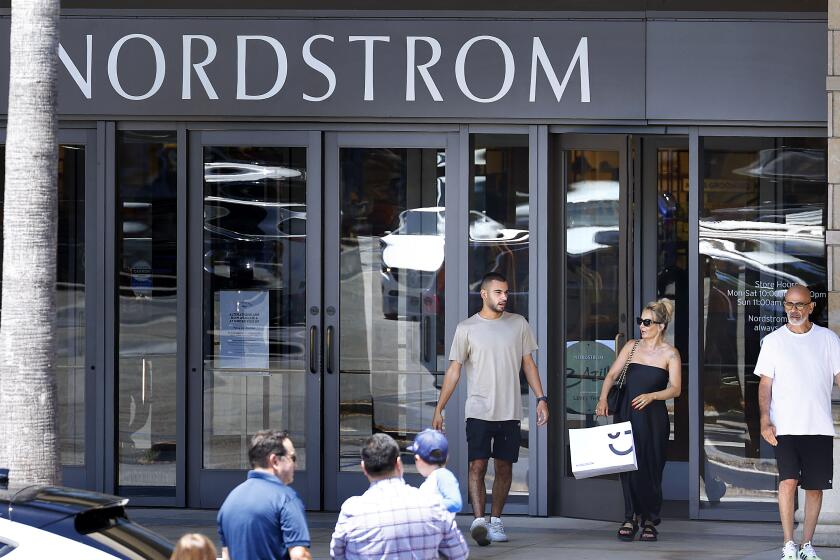Are HMOs Too Big to Go Bust? Just Ask Your Favorite Failed S
- Share via
Stop me if you’ve heard this one before:
A sleepy multibillion-dollar industry is thrust into the maelstrom of deregulation and restructuring. Traditions swiftly succumb to radical transformation. The lure of quick profits attracts hordes of entrepreneurs--some brilliant and honorable, others sleazily opportunistic. What’s more, this industry is “special”--everyone agrees that the government would never let it go bust. So Wall Street adores this fast-growing, innovative sector.
Inevitably, a few of the more aggressive operators make bad bets. They can’t generate the promised returns. Industry leaders get overextended. The regulators are confused. They try to force a few mergers, but bankruptcy starts to look awful appealing. Some of the biggest firms swiftly embrace it. The Justice Department aggressively investigates for fraud. Millions of angry customers--their life savings at risk--collectively scream for a government bailout. Bold legislation is proposed. A new agency is formed to oversee industry consolidation and asset fire sales. Out come the Lotus 1-2-3 spreadsheets. The estimated cost to America’s taxpayers? Hundreds of billions. This will ultimately become the biggest taxpayer bailout of a failing industry in American history.
Yet another recap of yesteryear’s savings and loan crisis? Not quite. But taxpayers beware: The S&L; saga--which is expected to cost taxpayers somewhere between $145 billion and more than $400 billion--offers uncanny insight into what will become tomorrow’s health-care headlines if history is nasty enough to repeat itself.
The rapid growth of today’s health maintenance organizations is eerily reminiscent of the early go-go good fortunes of the high-flying savings and loans. With comparable mismanagement, HMOs may well become the S&Ls; of the next millennium. Bankruptcy law may have a bigger impact on access to quality health care than all the medical schools combined.
“That’s not totally out of the question,” says journalist George Anders, who is finishing a book on HMOs, “but it’s hardly the most likely scenario.” Nevertheless, Anders and others acknowledge that the economics of today’s HMOs cannot support existing trends without some sort of radical restructuring.
“What happens when all those healthy 66-year-olds turn into 76-year-olds in need of serious medical care?” Anders asks. “Do the HMOs kick people out of coverage, cut back on the quality of care, double or triple their rates, or go down in flames financially trying to give everybody the quality care they expected when they signed up in the first place?”
That challenge is all the more acute given the recent surge in HMO coverage. Just as financial deregulation ignited the explosion in S&L; deposits, deregulation and cost-cutting initiatives have made HMOs the dominant medium for health-care coverage. Twenty-five years ago, barely 3 million Americans were enrolled in HMOs. A decade ago, about 20 million Americans were covered. Today, more than 52 million Americans are HMO plan enrollees, and the number is expected to exceed 65 million by the middle of next year. That doesn’t yet include the tens of millions of elderly participants as Medicare and Medicaid are brought into the HMO fold.
Of course, HMO networks won’t go bust lending money to aspiring Texas shopping mall moguls and Arizona real estate developers. The issue here isn’t bad loans and rising interest rates, it’s balancing promised business performance with promised quality and quantity of health care. That’s going to become ever harder to do.
Today, HMOs enjoy record profits. Industry profits rose roughly 40% from 1992 to 1994--and another 20% in 1995. Unfortunately for investors, it’s becoming more and more difficult for HMOs to squeeze cost savings out of traditional medical practices. Indeed, as the population ages--and new diagnostics and therapies materialize--cost pressures on HMOs intensify. A breakthrough in geriatric medicine--say, an expensive new drug to reduce damage from strokes in people over 65--could create enormous financial strains on some HMOs as people requiring more care live longer. Where do the investors go as fat profit margins contract?
Obviously, HMOs could simply jack up their rates (just as the S&Ls; could have lowered the rates they promised depositors). But that brings the country right back to the challenge of rising health costs. At some point, there will be calls for tax credits, tax deductions and/or direct tax subsidies to help pay for coverage for those who can’t afford HMO care. Either way, HMOs would de facto receive huge multibillion-dollar government subsidies for their customers.
But won’t competition slow health-care price increases? Sure, but a Frank Lorenzo (remember Eastern Airlines?) could emerge who tries to buy HMO market share by slashing prices. If it can’t be bought that way, well, perhaps bankruptcy would be a useful tactic to lower operating costs. What kind of pressures might a bankrupt HMO network put on its rivals? Who is going to be called upon to provide a safety net for all those middle-class voters left with minimal health-care coverage after faithfully paying their premiums?
Then again, HMOs could make more rigorous efforts to screen out the potentially more expensive enrollees from their plans. But that might set the stage for the sort of class-action lawsuit (think asbestos, IUDs) that could plunge an HMO into bankruptcy. What’s more, those suits could force HMOs to accept those undesirables as part of the settlement and thus create the very problems the HMOs were trying to avoid.
Similarly, HMOs could cut costs by cutting their quality of care. That’s already a hot topic of ethical and professional dispute. Of course, if the courts find that plans have fallen below a certain standard of care, those lawsuits will cost HMOs dearly too. Indeed, what happens if HMO plans can be held as liable as physicians for malpractice? The financial risks are potentially enormous. Investment becomes that much riskier. It’s a vicious spiral. So do we indemnify HMOs from liability lawsuits? Talk about multibillion-dollar subsidies!
The simple reality is that if HMOs are truly in a competitive, deregulated environment, there may be far more to learn from the S&L; crisis and the airline bankruptcy battles than from the administration of a well-run hospital. To lose one’s health-care coverage or have it renegotiated down to a bare minimum may make American taxpayers long for the criminal excesses of S&L; profiteers such as Charles Keating or David Paul.
In the past, bankrupt HMOs had their enrollees scattered to other plans--often with significant disruption of service. But the problems increase as the volume and importance of HMOs increase. Perhaps some HMOs will be declared “too big to fail”--just as the Federal Reserve Bank declared some banks were too big to fail. Perhaps there will be a Resolution Wellness Corp. to manage the fire sale of HMO assets, much as the recently shuttered Resolution Trust Corp. invited investors in to take over distressed S&Ls.;
Trend is not destiny. But if investors, depositors and regulators had been a little more diligent during the early days of S&L; deregulation, hundreds of billions of taxpayer dollars could have been saved. Would anyone disagree that, with health care, the stakes are even higher?
More to Read
Inside the business of entertainment
The Wide Shot brings you news, analysis and insights on everything from streaming wars to production — and what it all means for the future.
You may occasionally receive promotional content from the Los Angeles Times.










